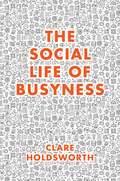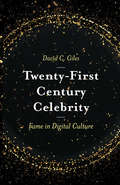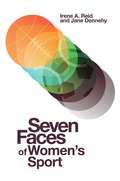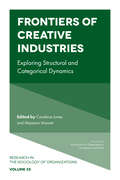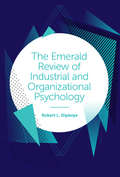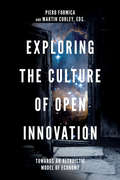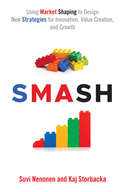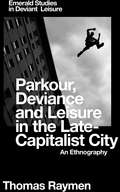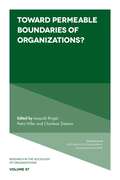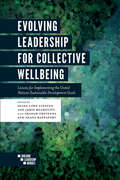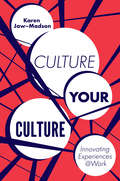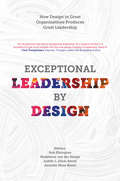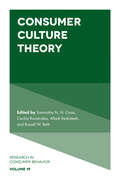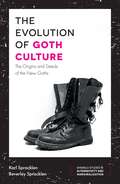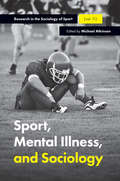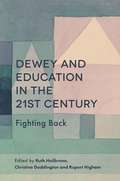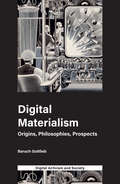- Table View
- List View
The Social Life of Busyness
by Clare HoldsworthClare Holdsworth develops an account of everyday busyness by identifying busyness with a relational interpretation of time. She analyses a variety of secondary data sources – one-day diaries, self-help books on busyness and time management, accounts of a writing day and interviews about family work and time – and combines these analyses with personal observations. By revealing busyness as the point at which we negotiate our own responsibilities and those of other people, and by showcasing how experiences of busyness are very varied, Holdsworth concludes that the tactics we use to deal with excessive busyness and the habits we develop in relation to it need to recognise the relational status of busyness. Rather than assuming that busyness is an issue that should be resolved by helping individuals manage their time better, she argues that busyness should be thought of as a collective challenge. This book encourages us to understand that time-management solutions need to focus on the spatial and temporal distributions of responsibilities and how people manage these responsibilities. It represents a timely call for collective responses to busyness in the aftermath of the Covid-19 pandemic, which has intensified the unequal distribution of responsibilities.
Twenty-First Century Celebrity: Fame in Digital Culture
by David C. GilesOver the first two decades of the 21st century, celebrity has undergone significant changes as mass media have shifted from a restricted broadcast model to a digital free-for-all. Existing celebrities have been forced to adapt their style of presentation to suit a more interactive environment where fans expect continuous access, while the emergent social media have generated new forms of celebrity that reflect the unique affordances of YouTube, Instagram and other platforms. In this book, David Giles argues that these developments are best understood by rethinking traditional concepts of media and audience in order to explain how a platform like YouTube has evolved its own media culture that affords a different type of celebrity to those associated with cinema, radio and television. Above all else, the 21st century celebrity is valued more for their (apparent) authenticity than for their glamour or talents, and Giles examines how that authenticity is a carefully crafted performance. Drawing extensively on the burgeoning celebrity studies literature, he explores the impact of digital culture on earlier concepts like parasocial relationships and celetoids as well as critiquing more recent ideas such as microcelebrity.
Seven Faces of Women's Sport
by Irene A. Reid Jane DennehyMedia and political figures often assert that progress towards achieving gender parity has advanced. However, circumstances around recent major sports events such as the Women's Football World Cup and Olympic Games suggest otherwise. From controversy around facilities to miniscule commercial sponsorship, from body confidence to physical literacy, from grassroots to elite performance these events reveal ideologies and barriers that mitigate against parity for women's sport remaining entrenched. An informed critical examination of interconnected issues around women and sport in the twenty-first century is absent from current scholarship. This book will explore some of the intersecting issues through the lens of 7 faces: governance, economics, nationhood, competition, bodies, sport for development and media. The collection seeks to amplify the ways in which inequalities are sustained by struggles between dominant social, political and economic power networks. We argue that only by making visible this complex matrix, does it become possible to create agendas for more rapid change to rebalance existing gender inequalities. The book seeks to disentangle some of the issues, and to disrupt conventional ways of thinking about gender inequalities in sport. Our thesis is that change is slow, but investment in different skills and knowledge could direct sustainable and strategically relevant change for women's sport.
Frontiers of Creative Industries: Exploring Structural and Categorical Dynamics (Research in the Sociology of Organizations #55)
by Candace Jones Massimo MaoretCreative industries are a growing and globally important area for both economic vitality and cultural expression of industrialized nations. The growth and dynamism of creative industries depends on “continuous innovation” that must manage inherent tensions such as novelty to attract consumers and sustain artistic expression and familiarity to aid comprehension and stabilize demand for cultural products. In this volume, the macro-structural conditions that shape creative industries – their institutional, categorical and structural dynamics- are examined to provide an overview of new trends and emerging issues in scholarship on this topic. Creative industries offer products and services that range from the prosaic to the sublime and provide meaning to our lives, and this volume features a wide range of examples, from advertising, to architecture, art markets, Champagne wine, fashion and music. Contributors examine topics such as the micro-interactions of brokerage relations; how actors transform a brokerage role from control to co-production to enact creative leadership; how investors provide legitimacy to the new categories such as abstract art; how technological disintermediation creates alternative category processes such as authenticity; how social relations shape social evaluation; how prototypical producers can trespass categories and avert negative evaluation; how personal styles enable social evaluation; and how the ambiguity of a category, such as Swing music, facilitated its adaptability and longevity. The volume concludes with an Afterword examining research on creative industries as a form of cultural product and a category in itself.
The Emerald Review of Industrial and Organizational Psychology (PDF)
by Robert L. DipboyeThis book provides an in depth survey of the field of Industrial and Organizational Psychology (I/O), a specialized field within the larger discipline of psychology also called Work and Organizational Psychology, Occupational Psychology, and Organizational Psychology. I/O is the scientific study of how individuals and groups behave in the performance of work activities and in the context of organizations. It is also the application of this research to improving the effectiveness and the well-being of people and the organizations in which they work. It is part science, contributing to the general knowledge base of psychology, and part application, using that knowledge to solve real-world problems.
Exploring the Culture of Open Innovation: Towards an Altruistic Model of Economy
by Piero Formica Martin CurleyAcclaimed entrepreneurship and innovation scholar Piero Formica, along with a strong and diverse cast of international contributors, explore the world of Open Innovation in this volume. Tackling new developments in the field, the authors examine altruism and the role of openness to unorthodox and unconventional experimentation as the newest arena to create modern knowledge resources and entrepreneurial ventures.
SMASH: Using Market Shaping to Design New Strategies for Innovation, Value Creation, and Growth (Series In International Business And Economics Ser.)
by Suvi Nenonen Kaj StorbackaStunningly, strategy has never adequately defined one of its central institutions, the market. Old playbooks got away with a hodgepodge of assertions, assumptions and approximations. But the undeniable complexity of modern markets confronts us with the truth. Markets are elaborate, evolving ecosystems – think biology, not machinery. Today, strategy must embrace complexity or die. Recognizing markets as complex adaptive systems spells strategic implications. Notably, as markets are partly socially constructed, they can be reconstructed. And while they cannot be predicted or controlled, they can be influenced. Rooted in the richness of market systems, SMASH traces the three main resulting shifts in strategic thinking: (1) from firm focus to context focus, where the relevant context is our definition of the market; (2) from competing and winning to value creation and cooperation; and (3) from analysis, prediction and planning to non-predictive strategizing and experimentation. Nenonen and Storbacka weave these three strands together into a cohesive strategic framework – Strategies for Market Shaping. Market shaping strategies acknowledge that much of firm performance is explained by the markets where a firm operates. Crucially, strategic choices go beyond market selection, entry and exit; firms should actively seek to adapt the market to the firm instead of the firm to the market, and open up untapped value in the process. Market shaping is not new. What is new is systematizing an actionable framework for understanding and shaping markets. And the good news: It does not take market power and resources, or intuitive genius, to shape markets to your own benefit. SMASH offers tangible strategies that savvy market shapers of any size can implement, making it a must-read.
Parkour, Deviance and Leisure in the Late-Capitalist City: An Ethnography (Emerald Studies in Deviant Leisure)
by Thomas RaymenTaking us on an ethnographic journey into the spatially transgressive practice of parkour and freerunning, Parkour, Deviance and Leisure in the Late-Capitalist City: An Ethnography attempts to explain and untangle some of the contradictions that surround this popular lifestyle sport and its exclusion from our hyper-regulated cities. While the existing criminological wisdom suggests that these practices are a form of politicised resistance, this book positions parkour and freerunning as hyper-conformist to the underlying values of consumer capitalism and explains how late-capitalism has created a contradiction for itself in which it must stoke desire for these lifestyle practices whilst also excluding their free practice from central urban spaces. Drawing on the emergent deviant leisure perspective, this book takes us into the life-worlds of young people who are attempting to navigate the challenges and anxieties of early adulthood. For the young people in this study, consumer capitalism's commodification of rebellious iconography offered unique identities of 'cool individualism' and opportunities for flexibilised employment; while the post-industrial 'creative city' attempted to harness parkour's practice, prohibitively if necessary, into approved spatial contexts under the buzzwords of 'culture' and 'creativity'. This book offers a vital contribution to the criminological literature on spatial transgression, and in doing so, engages in a critical reappraisal of the evolution of the relationships between work, leisure, identity and urban space in consumer capitalism.
Toward Permeable Boundaries of Organizations? (Research in the Sociology of Organizations #57)
by Leopold Ringel Petra Hiller Charlene ZietsmaThe classical concept of organizations as comprising solitary ‘walled-in’ actors with clear operational boundaries is increasingly being challenged. On the one hand, established organizational forms have been supplemented by a whole variety of new ones that only partially exhibit their properties and that frequently embed single organizations in national or transnational networks; furthermore, it is often not clear who the members of an organization are and what membership actually means, as in the case of new companies such as Uber or AirBnB, and even traditional organizations, such as universities, are undergoing drastic changes. On the other hand, organizations face increasing demands for transparency, meaning they have to disclose more and more information, which is supposed to engender less corruption, more efficiency, and more legitimacy. This volume investigates the impact of these changes on organizations and offers conceptual as well as empirical insights. Divided into four parts this volume examines concepts of organizational boundaries, boundaries and organizational dynamics, meta organization and organizational networks, and boundaries and organizational fields.
Frontiers of Creative Industries: Exploring Structural and Categorical Dynamics (Research in the Sociology of Organizations #55)
by Candace Jones Massimo MaoretCreative industries are a growing and globally important area for both economic vitality and cultural expression of industrialized nations. The growth and dynamism of creative industries depends on “continuous innovation” that must manage inherent tensions such as novelty to attract consumers and sustain artistic expression and familiarity to aid comprehension and stabilize demand for cultural products. In this volume, the macro-structural conditions that shape creative industries – their institutional, categorical and structural dynamics- are examined to provide an overview of new trends and emerging issues in scholarship on this topic. Creative industries offer products and services that range from the prosaic to the sublime and provide meaning to our lives, and this volume features a wide range of examples, from advertising, to architecture, art markets, Champagne wine, fashion and music. Contributors examine topics such as the micro-interactions of brokerage relations; how actors transform a brokerage role from control to co-production to enact creative leadership; how investors provide legitimacy to the new categories such as abstract art; how technological disintermediation creates alternative category processes such as authenticity; how social relations shape social evaluation; how prototypical producers can trespass categories and avert negative evaluation; how personal styles enable social evaluation; and how the ambiguity of a category, such as Swing music, facilitated its adaptability and longevity. The volume concludes with an Afterword examining research on creative industries as a form of cultural product and a category in itself.
SMASH: Using Market Shaping to Design New Strategies for Innovation, Value Creation, and Growth (Series In International Business And Economics Ser.)
by Suvi Nenonen Kaj StorbackaStunningly, strategy has never adequately defined one of its central institutions, the market. Old playbooks got away with a hodgepodge of assertions, assumptions and approximations. But the undeniable complexity of modern markets confronts us with the truth. Markets are elaborate, evolving ecosystems – think biology, not machinery. Today, strategy must embrace complexity or die. Recognizing markets as complex adaptive systems spells strategic implications. Notably, as markets are partly socially constructed, they can be reconstructed. And while they cannot be predicted or controlled, they can be influenced. Rooted in the richness of market systems, SMASH traces the three main resulting shifts in strategic thinking: (1) from firm focus to context focus, where the relevant context is our definition of the market; (2) from competing and winning to value creation and cooperation; and (3) from analysis, prediction and planning to non-predictive strategizing and experimentation. Nenonen and Storbacka weave these three strands together into a cohesive strategic framework – Strategies for Market Shaping. Market shaping strategies acknowledge that much of firm performance is explained by the markets where a firm operates. Crucially, strategic choices go beyond market selection, entry and exit; firms should actively seek to adapt the market to the firm instead of the firm to the market, and open up untapped value in the process. Market shaping is not new. What is new is systematizing an actionable framework for understanding and shaping markets. And the good news: It does not take market power and resources, or intuitive genius, to shape markets to your own benefit. SMASH offers tangible strategies that savvy market shapers of any size can implement, making it a must-read.
Evolving Leadership for Collective Wellbeing: Lessons for Implementing the United Nations Sustainable Development Goals (Building Leadership Bridges)
by Seana Lowe Steffen Jamie Rezmovits Shanah Trevenna Shana RappaportHistory was made when the United Nations published Transforming Our World: The 2030 Agenda for Sustainable Development and world leaders stepped up to pledge unifying commitments to secure a sustainable future "where all life can thrive." Now, we the people—the world's individuals, organizations, and communities that have been championing the shared vision of a sustainable future—need access to the best leadership guidance available to build on the successes of past efforts and advance breakthrough progress. Evolving Leadership for Collective Wellbeing: Lessons for Implementing the United Nations Sustainable Development Goals provides that guidance. This collection is a go-to resource for individuals wishing to heighten leadership effectiveness through access to vanguard theory and practice. It highlights stories and insights from leadership practitioners and scholars around the world, in the process offering invaluable insights into diverse lessons, models, and practices, and it offers case and place-based chapters that bridge theory and practice to empower diverse actors around the world. As the Agenda acknowledges, "The future of humanity and of our planet lies in our hands. ... It will be for all of us to ensure that the journey is successful and its gains irreversible." Evolving Leadership for Collective Wellbeing is essential reading not only for leaders and leadership scholars, but also for anyone eager to face the Agenda’s challenge head on.
Culture Your Culture: Innovating Experiences @Work
by Karen Jaw-MadsonOrganizational culture isn't just a hot topic--it's an untapped asset and potential liability for all businesses. And yet, for all its potential to make or break, few know how to manage cultures with proficiency. Culture Your Culture: Innovating Experiences @Work provides the much-needed "how-to" with Design of Work Experience (DOWE). Tapping into human-centered design, interdisciplinary innovation concepts, and other research, this leading edge approach partners employees and their employers in unprecedented ways to co-create solutions and differentiating experiences that are customized, relevant, and profoundly impactful to the organizations for which they are intended--all while building employee engagement, learning agility, and capability. Be open to changing mindsets, for this is not your typical business book. Part-business case, part-instructional, and part-commentary, the guidance offered here puts your organization--not some detached case studies--at the center to envision how DOWE can help you design solutions and experiences unique to your context. Culture will no longer be esoteric or intangible, but overt, meaningful, fully leveraged, and truly experienced. No more hacking through trial and error to a culture that lacks sustainability. We can practice the management of culture and organizational change through lived experiences, with intention, rigor, and discipline. Leaders, managers, teams, and employees alike will benefit from understanding the need for this approach, how it's defined, why it works, and what to do to successfully tackle business challenges and positively influence lives with this innovative model--if you are willing to do the work to get there.
Exceptional Leadership by Design: How Design in Great Organizations Produces Great Leadership
by Rob Elkington Madeleine van der Steege Judith Glick-Smith Jennifer Moss BreenImagine a world with great leadership. What would that world be like? Would it be a better world or a worse one? Now ratchet great leadership up to exceptional leadership and suddenly we have cause for optimism. But how do we design exceptional leadership, and would we even know it if we saw it? Traditional paradigms of leadership have celebrated decisive top-down control and analytical decision-making. But times are changing. The world is more connected, complex, fluid and interdependent. This book debunks the myth that leaders need to be creative like designers to apply Design Thinking. Applying design approaches and practices to organizational leadership is not just about its leaders becoming more creative. It is definitely not about the person at the top coming up with the grand answer. Design thinking starts with the 'pain point' related to the problem you are trying to solve. You get to the heart of the issue. It is a collaborative effort that neatly leads stakeholders and representatives affected by the problem to design novel leadership solutions that actually work. This collection of stories, examples and narratives about exceptional leadership by design provides readers of all levels of experience with tangible, real, and heartfelt examples of how the design process can be applied to leadership. It will show how we: Inform great leadership with design Strengthen our own leadership by design Redesign hero leadership for more inclusivity Redesign organizations for Fe+Male leadership synergy Design leadership for a VUCA world Design flow-based leadership Design organizations that build resilient leadership Design leadership for innovation Design culturally intelligent leadership Build leadership into our spaces and places
Consumer Culture Theory (Research in Consumer Behavior #19)
by Samantha N. Cross Cecilia Ruvalcaba Alladi Venkatesh Russell W. BelkThis series epitomizes the 2017 Consumer Culture Theory (CCT) conference themes of hyper-reality and cultural hybridization. The partnership of the co-editors, with diverse backgrounds including Caribbean, Mexican and Indian roots, itself depicts cultural hybridity, culminating in a series of fascinating articles written by authors from around the globe. The eleven research papers provide a global perspective on a range of consumer discourses both in the physical marketplace (research on mobility practices within the transportation market in Vietnam; or an examination of stigma in beef consumption practices in India), or in the virtual marketplace (a study of the discourses surrounding the mythic nature of Bitcoin creator, Satoshi Nakamoto; or parental management understood through the media marketplace experiences of black women in Britain). The conference’s Best Competitive Award paper is featured; a compelling look at hyper-reality within the world of the Broadway musical, Wicked, examining how new media platforms are used to appeal to new and existing consumers. This series also includes two insightful papers on wine producers and their cultural intermediaries, and on wine tourism, where the authors traverse the globe to better understand market development and consumer engagement respectively. Whether it be an examination of consumer tribes, breast cancer and gender identity, or product gender and design, these authors collectively provide us with unique and riveting perspectives on consumer and marketplace experiences. The series fittingly culminates with a critical look at the emergence of the CCT tradition; an emergence that is both timely and important as this series demonstrates.
Bureaucracy and Society in Transition: Comparative Perspectives (Comparative Social Research #33)
by Haldor Byrkjeflot Fredrick EngelstadNew Public Management has held a central position within public administration over the past few decades, complemented by various models promoting post-bureaucratic organization. But ‘traditional’ bureaucracy has not disappeared, and bureaucracy is in transition in the West and the rest of the world. Bureaucracies still fill crucial positions in modern societies, despite growing criticism of assumed inefficiencies and unlimited growth. This volume examines a range of issues related to bureaucracies in transition across Europe, with a particular focus on the Nordic region. Chapters examine a range of topics including a reinterpretation of Weber’s conception of bureaucracy; the historical development of institutions and organizational structures in Sweden and Greece; the myth of bureaucratic neutrality and the concept of ‘competent neutrality’; performance management systems; the anti-bureaucratic identities of senior civil servants; the role of experts and expertise in bureaucratic organizations; the impact of reform on public sector executives; the curbing of corruption in Scandinavian states; an interrogation of the Nordic administrative model; Supreme Audit Institutions; ‘street-level’ bureaucracy; and the establishment of an ‘ethics of office’ amongst Danish civil servants.
The Evolution of Goth Culture: The Origins and Deeds of the New Goths (Emerald Studies in Alternativity and Marginalization)
by Karl Spracklen Beverley SpracklenThe origins and deeds of the old Goths were constructed by Roman historians in fear of the Goth as a barbarian outsider; at the same time, the Goths were themselves the heroic subject of their own histories, constructed by their supporters as stories of their mythical origin and the deeds that led them to be rulers of their own kingdoms in post-Roman Late Antiquity. Who the old Goths were, their origins and their deeds, was a product of history, historiography and myth-making. In this book, Spracklen and Spracklen use the idea of collective memory to explore the controversies and boundary-making surrounding the genesis and progression of the modern gothic alternative culture. Spracklen and Spracklen argue that goth as sub-culture in the eighties was initially counter cultural, political and driven by a musical identity that emerged from punk. However, as goth music globalised and became another form of pop and rock music, goth in the nineties retreated into an alternative sub-culture based primarily on style and a sense of transgression and profanity. By this century goth became the focus of teenage rebellions, moral panics and growing commodification of counter-cultural resistance, so that by the goth has effectively become another fashion choice in the late-modern hyper-real shopping malls, devoid generally of resistance and politics. Goth, like punk, is in danger of being co-opted altogether by capitalism. This book suggests that the only way for goth culture to survive is if it becomes transgressive and radical again.
Sport, Mental Illness and Sociology (Research in the Sociology of Sport #11)
by Michael AtkinsonAt a time when the public discussion of mental illness in society is reaching a high point, athletes and other sports insiders remain curiously silent about their private battles with a range of mental illnesses. While a series of professional athletes have exposed the deep, dark secret related to the pervasiveness of mental illness in high performance sport, relatively little is known, sociologically, about what mental illness culturally means inside sport. This edited collection showcases research on how sport, as a social institution, may actually produce dangerous cultural practices and contexts that foster the development of mental illness within athlete groups. Further, chapters also illustrate how sport, when organized with sensitivity and care, may serve to help manage mental illnesses. Rather than analyzing mental illness as an individual phenomenon, contributors to this volume equally attest to how mental illness is socially developed, constructed, managed, and culturally understood within sport settings. The book highlights the relevance of a range of theories pertinent to the social study of mental illness including dramaturgy, cultural studies, learning theory, symbolic interaction, existentialism, and total pain theory. Chapters range from the discussion of depression, anxiety, eating disorders, drug addiction, epilepsy, mental trauma, stigma, the mass mediation of mental illness, and the promise of sport as a vehicle for personal and collective recovery.
Dewey and Education in the 21st Century: Fighting Back
by Dr Ruth Heilbronn Dr Christine Doddington Dr Rupert HighamThis book makes a strong case for the abiding relevance of Dewey’s notion of learning through experience, with a community of others and what this implies for democratic education in the 21st century. Its first section addresses the experience of today’s generation of so-called ‘digital natives’ in terms of how we should now understand ‘knowledge’ and how their online experience creates opportunities and challenges for the curriculum, such as schools linking internationally to study classical texts; an exposition of why makerspaces, hackerspaces and Fab Labs might support Dewey’s democratic communities in our time, with on-line affordances of ‘a commons’, a space to use imagination and invent and share with others. The book’s second section is original in its focus on the central Deweyan idea of ‘embodiment’ with chapters on Dewey and the Alexander technique and on experiences of Afro-American students, in public schools, especially those situated in multi-racial, multi-ethnic countries like the U.S. with deep, racial divides and tensions. The section ends with a chapter on the somaesthetic, educational value of learning outside of buildings. A third section on experience related to democracy and education, has chapters on Dewey and the democratic curriculum, experience as a preparation for democracy, communication and the critique of individualism. Dewey’s notion of interest is analyzed and questioned as to whether it is a sympathetic notion for educational development. With contributions from Spain, Cameroon, the US and the UK the book ranges across varied curricular and policy contexts to explore what reading Dewey can contribute to contemporary education studies.
Digital Materialism: Origins, Philosophies, Prospects (Digital Activism and Society: Politics, Economy and Culture in Network Communication (PDF))
by Dr Baruch GottliebDigital materiality (digimat) proposes a set of basic principles for how we understand the world through digital processes. Digital instruments may seem forbiddingly complex but they are based on simple mechanical principles which operate today on the subatomic scale, creating challenges for conventional human epistemology. This short book sets out a methodical materialist understanding of digital technologies, where they come from, how they work, and what they do. This analysis starts from the classical materialism of the Greek physicist-philosophers, engages with the humanist and historical materialism of the flourishing of Enlightenment arts and sciences, and extrapolates from post-humanist new materialism informed by quantum physics. There can be no future without a present and that present is always, persistently material. Readers of this book must grapple with the mattering of digital material, especially the awe-inspiring epistemological schism between the infinitesimal, lightspeed reality of digital data and conventional, empirical human epistemologies which provide the vocabularies and cultural metaphors we must have recourse to in the attempt to discuss, communicate and decypher these phenomena. The obsolescent figure of anthropos (human being) will provide a central foil and subject for this challenge to understand our digital tools and their seemingly irrepressible reproduction. The future of humanity is at stake!
Twenty-First Century Celebrity: Fame in Digital Culture
by David C. GilesOver the first two decades of the 21st century, celebrity has undergone significant changes as mass media have shifted from a restricted broadcast model to a digital free-for-all. Existing celebrities have been forced to adapt their style of presentation to suit a more interactive environment where fans expect continuous access, while the emergent social media have generated new forms of celebrity that reflect the unique affordances of YouTube, Instagram and other platforms. In this book, David Giles argues that these developments are best understood by rethinking traditional concepts of media and audience in order to explain how a platform like YouTube has evolved its own media culture that affords a different type of celebrity to those associated with cinema, radio and television. Above all else, the 21st century celebrity is valued more for their (apparent) authenticity than for their glamour or talents, and Giles examines how that authenticity is a carefully crafted performance. Drawing extensively on the burgeoning celebrity studies literature, he explores the impact of digital culture on earlier concepts like parasocial relationships and celetoids as well as critiquing more recent ideas such as microcelebrity.
Seven Faces of Women's Sport
by Irene A. Reid Jane DennehyMedia and political figures often assert that progress towards achieving gender parity has advanced. However, circumstances around recent major sports events such as the Women's Football World Cup and Olympic Games suggest otherwise. From controversy around facilities to miniscule commercial sponsorship, from body confidence to physical literacy, from grassroots to elite performance these events reveal ideologies and barriers that mitigate against parity for women's sport remaining entrenched. An informed critical examination of interconnected issues around women and sport in the twenty-first century is absent from current scholarship. This book will explore some of the intersecting issues through the lens of 7 faces: governance, economics, nationhood, competition, bodies, sport for development and media. The collection seeks to amplify the ways in which inequalities are sustained by struggles between dominant social, political and economic power networks. We argue that only by making visible this complex matrix, does it become possible to create agendas for more rapid change to rebalance existing gender inequalities. The book seeks to disentangle some of the issues, and to disrupt conventional ways of thinking about gender inequalities in sport. Our thesis is that change is slow, but investment in different skills and knowledge could direct sustainable and strategically relevant change for women's sport.
The Emerald Review of Industrial and Organizational Psychology
by Robert L. DipboyeThis book provides an in depth survey of the field of Industrial and Organizational Psychology (I/O), a specialized field within the larger discipline of psychology also called Work and Organizational Psychology, Occupational Psychology, and Organizational Psychology. I/O is the scientific study of how individuals and groups behave in the performance of work activities and in the context of organizations. It is also the application of this research to improving the effectiveness and the well-being of people and the organizations in which they work. It is part science, contributing to the general knowledge base of psychology, and part application, using that knowledge to solve real-world problems.
Exploring the Culture of Open Innovation: Towards an Altruistic Model of Economy
by Piero Formica Martin CurleyAcclaimed entrepreneurship and innovation scholar Piero Formica, along with a strong and diverse cast of international contributors, explore the world of Open Innovation in this volume. Tackling new developments in the field, the authors examine altruism and the role of openness to unorthodox and unconventional experimentation as the newest arena to create modern knowledge resources and entrepreneurial ventures.
Parkour, Deviance and Leisure in the Late-Capitalist City: An Ethnography (Emerald Studies in Deviant Leisure)
by Thomas RaymenTaking us on an ethnographic journey into the spatially transgressive practice of parkour and freerunning, Parkour, Deviance and Leisure in the Late-Capitalist City: An Ethnography attempts to explain and untangle some of the contradictions that surround this popular lifestyle sport and its exclusion from our hyper-regulated cities. While the existing criminological wisdom suggests that these practices are a form of politicised resistance, this book positions parkour and freerunning as hyper-conformist to the underlying values of consumer capitalism and explains how late-capitalism has created a contradiction for itself in which it must stoke desire for these lifestyle practices whilst also excluding their free practice from central urban spaces. Drawing on the emergent deviant leisure perspective, this book takes us into the life-worlds of young people who are attempting to navigate the challenges and anxieties of early adulthood. For the young people in this study, consumer capitalism's commodification of rebellious iconography offered unique identities of 'cool individualism' and opportunities for flexibilised employment; while the post-industrial 'creative city' attempted to harness parkour's practice, prohibitively if necessary, into approved spatial contexts under the buzzwords of 'culture' and 'creativity'. This book offers a vital contribution to the criminological literature on spatial transgression, and in doing so, engages in a critical reappraisal of the evolution of the relationships between work, leisure, identity and urban space in consumer capitalism.
